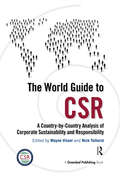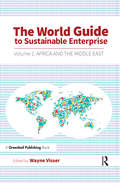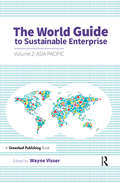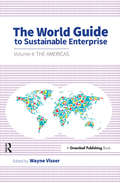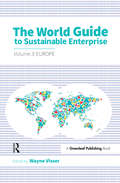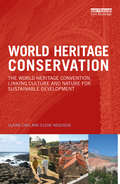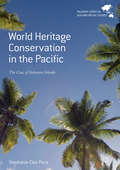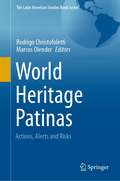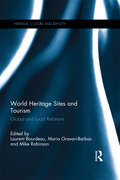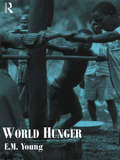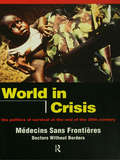- Table View
- List View
World Globe Centred on North America (UEB uncontracted)
by RnibThis is a globe map centred on North America. As the land masses shown are on the curved surface of the Earth, this image will be distorted, especially at its edge. There is a locator dot shown, which will be at the top left of the page when the image is the correct way up. Land is shown on the tactile image as a fine dotted texture and the sea by fine horizontal lines. These are green and blue respectively on the Large Print image. This globe map represents the Earth as seen from space, directly above North America. The USA is in the centre of the globe map. Up from the USA are Canada and the Northwestern Passages. Greenland and the small island of Iceland are to the right of this. Down the page from North America is South America and to the right is the edge of Africa and Europe.
World Globe Centred on South America (large print)
by RnibThis is a globe map centred on South America. As the land masses shown are on the curved surface of the Earth, this image will be distorted, especially at its edge. There is a locator dot shown, which will be at the top left of the page when the image is the correct way up. Land is shown on the tactile image as a fine dotted texture and the sea by fine horizontal lines. These are green and blue respectively on the Large Print image. This globe map represents the Earth as seen from space, directly above South America. South America is in the centre of the globe map. Up and left are the thin strip of Central America, the islands of Cuba, Haiti and the Dominican Republic, and North America. To the right of South America is a distorted view of West Africa and Western Europe.
World Globe Centred on South America (UEB contracted)
by RnibThis is a globe map centred on South America. As the land masses shown are on the curved surface of the Earth, this image will be distorted, especially at its edge. There is a locator dot shown, which will be at the top left of the page when the image is the correct way up. Land is shown on the tactile image as a fine dotted texture and the sea by fine horizontal lines. These are green and blue respectively on the Large Print image. This globe map represents the Earth as seen from space, directly above South America. South America is in the centre of the globe map. Up and left are the thin strip of Central America, the islands of Cuba, Haiti and the Dominican Republic, and North America. To the right of South America is a distorted view of West Africa and Western Europe.
World Globe Centred on South America (UEB uncontracted)
by RnibThis is a globe map centred on South America. As the land masses shown are on the curved surface of the Earth, this image will be distorted, especially at its edge. There is a locator dot shown, which will be at the top left of the page when the image is the correct way up. Land is shown on the tactile image as a fine dotted texture and the sea by fine horizontal lines. These are green and blue respectively on the Large Print image. This globe map represents the Earth as seen from space, directly above South America. South America is in the centre of the globe map. Up and left are the thin strip of Central America, the islands of Cuba, Haiti and the Dominican Republic, and North America. To the right of South America is a distorted view of West Africa and Western Europe.
The World Guide to CSR: A Country-by-Country Analysis of Corporate Sustainability and Responsibility
by Wayne Visser Nick TolhurstThe World Guide to CSR is the first book to provide comparable national profiles that describe the evolution and practice of Corporate Sustainability and Responsibility (CSR) for 58 countries and 5 global regions. Each regional and national profile includes key information about the relevant CSR history, country-specific issues, trends, research and leading organizations. The purpose of the book is to give CSR professionals (including managers, consultants, academics and NGOs focusing on the social, environmental and ethical responsibilities of business) a quick reference guide to CSR in different regional and national contexts. The need for the book is premised on the fact that CSR professionals and researchers more often than not have a multinational remit and are required to benchmark performance internationally, but find that country-specific CSR information is ad hoc, limited or non-existent. Even where national CSR research exists, it is often hidden in academic journals that practitioners cannot access or do not have the time or inclination to read. The book is an edited volume, with expert contributors from around the world, all of whom have been screened and selected on the basis of their qualifications and experience in CSR. Each regional/country profile includes the following subsections:CSR in context Priority issues Trends Legislation and codes Organizations Case studies Educational institutions References This unique resource will be an essential acquisition for all organisations who need to benchmark their CSR strategies throughout different regions and cultures and want the best possible intelligence on the key issues and concerns relating to corporate social responsibility in all of the markets in which they operate.
The World Guide to CSR: A Country-by-Country Analysis of Corporate Sustainability and Responsibility
by Wayne Visser Nick TolhurstThe World Guide to CSR is the first book to provide comparable national profiles that describe the evolution and practice of Corporate Sustainability and Responsibility (CSR) for 58 countries and 5 global regions. Each regional and national profile includes key information about the relevant CSR history, country-specific issues, trends, research and leading organizations. The purpose of the book is to give CSR professionals (including managers, consultants, academics and NGOs focusing on the social, environmental and ethical responsibilities of business) a quick reference guide to CSR in different regional and national contexts. The need for the book is premised on the fact that CSR professionals and researchers more often than not have a multinational remit and are required to benchmark performance internationally, but find that country-specific CSR information is ad hoc, limited or non-existent. Even where national CSR research exists, it is often hidden in academic journals that practitioners cannot access or do not have the time or inclination to read. The book is an edited volume, with expert contributors from around the world, all of whom have been screened and selected on the basis of their qualifications and experience in CSR. Each regional/country profile includes the following subsections:CSR in context Priority issues Trends Legislation and codes Organizations Case studies Educational institutions References This unique resource will be an essential acquisition for all organisations who need to benchmark their CSR strategies throughout different regions and cultures and want the best possible intelligence on the key issues and concerns relating to corporate social responsibility in all of the markets in which they operate.
The World Guide to Sustainable Enterprise: Volume 1: Africa and Middle East
by Wayne VisserThe World Guide to Sustainable Enterprise is the first comprehensive global compendium that clearly describes the national approaches to sustainable enterprise. Through a systematic review of each country, this quick-to-access reference guide showcases the similarities and differences in each region. Every country profile includes key information about the relevant history, country-specific issues, trends, research, and the leading organizations operating in the field as well as best-practice case studies. The guide comprises four volumes, each dedicated to a specific region of the world. In a world where organizations are working increasingly across national and regional boundaries and research takes a joined-up and international approach, this book is an essential guide for practitioners and researchers in the disciplines of business sustainability, social enterprise and corporate responsibility. The first of its kind, this reference book provides the reader with a unique insight into what is the current state-of-play in each country. Each edited volume provides expert contributions from around the world; the contributors have been selected on the basis of their knowledge of the country and their clear experience in sustainable enterprise. Each regional/country profile includes the following subsections: Sustainable Enterprise in context; Priority issues; Trends; Government policies; Case studies; Further resources; and References. This unique resource will be an essential acquisition for all organizations who need to benchmark their sustainable enterprise strategies throughout different regions and cultures and want the best possible intelligence on the key issues and concerns relating to sustainable business and social responsibility in all of the markets in which they operate. It provides a useful companion reference collection to The World Guide to CSR, also edited by Wayne Visser. The full Four Volume Set of The World Guide to Sustainable Enterprise is available for purchase as a single item at a 25% discounted rate.
The World Guide to Sustainable Enterprise: Volume 2: Asia Pacific
by Wayne VisserThe World Guide to Sustainable Enterprise is the first comprehensive global compendium that clearly describes the national approaches to sustainable enterprise. Through a systematic review of each country, this quick-to-access reference guide showcases the similarities and differences in each region. Every country profile includes key information about the relevant history, country-specific issues, trends, research, and the leading organizations operating in the field as well as best-practice case studies. The guide comprises four volumes, each dedicated to a specific region of the world. In a world where organizations are working increasingly across national and regional boundaries and research takes a joined-up and international approach, this book is an essential guide for practitioners and researchers in the disciplines of business sustainability, social enterprise and corporate responsibility. The first of its kind, this reference book provides the reader with a unique insight into what is the current state-of-play in each country. Each edited volume provides expert contributions from around the world; the contributors have been selected on the basis of their knowledge of the country and their clear experience in sustainable enterprise. Each regional/country profile includes the following subsections: Sustainable Enterprise in context; Priority issues; Trends; Government policies; Case studies; Further resources; and References. This unique resource will be an essential acquisition for all organizations who need to benchmark their sustainable enterprise strategies throughout different regions and cultures and want the best possible intelligence on the key issues and concerns relating to sustainable business and social responsibility in all of the markets in which they operate. It provides a useful companion reference collection to the World Guide to CSR, also edited by Wayne Visser. The full Four Volume Set of The World Guide to Sustainable Enterprise is available for purchase as a single item at a 25% discounted rate.
The World Guide to Sustainable Enterprise: Volume 4: the Americas
by Wayne VisserThe World Guide to Sustainable Enterprise is the first comprehensive global compendium that clearly describes the national approaches to sustainable enterprise. Through a systematic review of each country, this quick-to-access reference guide showcases the similarities and differences in each region. Every country profile includes key information about the relevant history, country-specific issues, trends, research, and the leading organizations operating in the field as well as best-practice case studies. The guide comprises four volumes, each dedicated to a specific region of the world. In a world where organizations are working increasingly across national and regional boundaries and research takes a joined-up and international approach, this book is an essential guide for practitioners and researchers in the disciplines of business sustainability, social enterprise and corporate responsibility. The first of its kind, this reference book provides the reader with a unique insight into what is the current state-of-play in each country. Each edited volume provides expert contributions from around the world; the contributors have been selected on the basis of their knowledge of the country and their clear experience in sustainable enterprise. Each regional/country profile includes the following subsections: Sustainable Enterprise in context; Priority issues; Trends; Government policies; Case studies; Further resources; and References. This unique resource will be an essential acquisition for all organizations who need to benchmark their sustainable enterprise strategies throughout different regions and cultures and want the best possible intelligence on the key issues and concerns relating to sustainable business and social responsibility in all of the markets in which they operate. It provides a useful companion reference collection to the World Guide to CSR, also edited by Wayne Visser. The full Four Volume Set of The World Guide to Sustainable Enterprise is available for purchase as a single item at a 25% discounted rate.
The World Guide to Sustainable Enterprise: Volume 2: Asia Pacific
by Wayne VisserThe World Guide to Sustainable Enterprise is the first comprehensive global compendium that clearly describes the national approaches to sustainable enterprise. Through a systematic review of each country, this quick-to-access reference guide showcases the similarities and differences in each region. Every country profile includes key information about the relevant history, country-specific issues, trends, research, and the leading organizations operating in the field as well as best-practice case studies. The guide comprises four volumes, each dedicated to a specific region of the world. In a world where organizations are working increasingly across national and regional boundaries and research takes a joined-up and international approach, this book is an essential guide for practitioners and researchers in the disciplines of business sustainability, social enterprise and corporate responsibility. The first of its kind, this reference book provides the reader with a unique insight into what is the current state-of-play in each country. Each edited volume provides expert contributions from around the world; the contributors have been selected on the basis of their knowledge of the country and their clear experience in sustainable enterprise. Each regional/country profile includes the following subsections: Sustainable Enterprise in context; Priority issues; Trends; Government policies; Case studies; Further resources; and References. This unique resource will be an essential acquisition for all organizations who need to benchmark their sustainable enterprise strategies throughout different regions and cultures and want the best possible intelligence on the key issues and concerns relating to sustainable business and social responsibility in all of the markets in which they operate. It provides a useful companion reference collection to the World Guide to CSR, also edited by Wayne Visser. The full Four Volume Set of The World Guide to Sustainable Enterprise is available for purchase as a single item at a 25% discounted rate.
The World Guide to Sustainable Enterprise: Volume 1: Africa and Middle East
by Wayne VisserThe World Guide to Sustainable Enterprise is the first comprehensive global compendium that clearly describes the national approaches to sustainable enterprise. Through a systematic review of each country, this quick-to-access reference guide showcases the similarities and differences in each region. Every country profile includes key information about the relevant history, country-specific issues, trends, research, and the leading organizations operating in the field as well as best-practice case studies. The guide comprises four volumes, each dedicated to a specific region of the world. In a world where organizations are working increasingly across national and regional boundaries and research takes a joined-up and international approach, this book is an essential guide for practitioners and researchers in the disciplines of business sustainability, social enterprise and corporate responsibility. The first of its kind, this reference book provides the reader with a unique insight into what is the current state-of-play in each country. Each edited volume provides expert contributions from around the world; the contributors have been selected on the basis of their knowledge of the country and their clear experience in sustainable enterprise. Each regional/country profile includes the following subsections: Sustainable Enterprise in context; Priority issues; Trends; Government policies; Case studies; Further resources; and References. This unique resource will be an essential acquisition for all organizations who need to benchmark their sustainable enterprise strategies throughout different regions and cultures and want the best possible intelligence on the key issues and concerns relating to sustainable business and social responsibility in all of the markets in which they operate. It provides a useful companion reference collection to The World Guide to CSR, also edited by Wayne Visser. The full Four Volume Set of The World Guide to Sustainable Enterprise is available for purchase as a single item at a 25% discounted rate.
The World Guide to Sustainable Enterprise: Volume 4: the Americas
by Wayne VisserThe World Guide to Sustainable Enterprise is the first comprehensive global compendium that clearly describes the national approaches to sustainable enterprise. Through a systematic review of each country, this quick-to-access reference guide showcases the similarities and differences in each region. Every country profile includes key information about the relevant history, country-specific issues, trends, research, and the leading organizations operating in the field as well as best-practice case studies. The guide comprises four volumes, each dedicated to a specific region of the world. In a world where organizations are working increasingly across national and regional boundaries and research takes a joined-up and international approach, this book is an essential guide for practitioners and researchers in the disciplines of business sustainability, social enterprise and corporate responsibility. The first of its kind, this reference book provides the reader with a unique insight into what is the current state-of-play in each country. Each edited volume provides expert contributions from around the world; the contributors have been selected on the basis of their knowledge of the country and their clear experience in sustainable enterprise. Each regional/country profile includes the following subsections: Sustainable Enterprise in context; Priority issues; Trends; Government policies; Case studies; Further resources; and References. This unique resource will be an essential acquisition for all organizations who need to benchmark their sustainable enterprise strategies throughout different regions and cultures and want the best possible intelligence on the key issues and concerns relating to sustainable business and social responsibility in all of the markets in which they operate. It provides a useful companion reference collection to the World Guide to CSR, also edited by Wayne Visser. The full Four Volume Set of The World Guide to Sustainable Enterprise is available for purchase as a single item at a 25% discounted rate.
The World Guide to Sustainable Enterprise - Volume 3: Europe
by Wayne VisserThe World Guide to Sustainable Enterprise is the first comprehensive global compendium that clearly describes the national approaches to sustainable enterprise. Through a systematic review of each country, this quick-to-access reference guide showcases the similarities and differences in each region. Every country profile includes key information about the relevant history, country-specific issues, trends, research, and the leading organizations operating in the field as well as best-practice case studies. The guide comprises four volumes, each dedicated to a specific region of the world. In a world where organizations are working increasingly across national and regional boundaries and research takes a joined-up and international approach, this book is an essential guide for practitioners and researchers in the disciplines of business sustainability, social enterprise and corporate responsibility. The first of its kind, this reference book provides the reader with a unique insight into what is the current state-of-play in each country. Each edited volume provides expert contributions from around the world; the contributors have been selected on the basis of their knowledge of the country and their clear experience in sustainable enterprise. Each regional/country profile includes the following subsections: Sustainable Enterprise in context; Priority issues; Trends; Government policies; Case studies; Further resources; and References. This unique resource will be an essential acquisition for all organizations who need to benchmark their sustainable enterprise strategies throughout different regions and cultures and want the best possible intelligence on the key issues and concerns relating to sustainable business and social responsibility in all of the markets in which they operate. It provides a useful companion reference collection to the World Guide to CSR, also edited by Wayne Visser. The full Four Volume Set of The World Guide to Sustainable Enterprise is available for purchase as a single item at a 25% discounted rate.
The World Guide to Sustainable Enterprise - Volume 3: Europe
by Wayne VisserThe World Guide to Sustainable Enterprise is the first comprehensive global compendium that clearly describes the national approaches to sustainable enterprise. Through a systematic review of each country, this quick-to-access reference guide showcases the similarities and differences in each region. Every country profile includes key information about the relevant history, country-specific issues, trends, research, and the leading organizations operating in the field as well as best-practice case studies. The guide comprises four volumes, each dedicated to a specific region of the world. In a world where organizations are working increasingly across national and regional boundaries and research takes a joined-up and international approach, this book is an essential guide for practitioners and researchers in the disciplines of business sustainability, social enterprise and corporate responsibility. The first of its kind, this reference book provides the reader with a unique insight into what is the current state-of-play in each country. Each edited volume provides expert contributions from around the world; the contributors have been selected on the basis of their knowledge of the country and their clear experience in sustainable enterprise. Each regional/country profile includes the following subsections: Sustainable Enterprise in context; Priority issues; Trends; Government policies; Case studies; Further resources; and References. This unique resource will be an essential acquisition for all organizations who need to benchmark their sustainable enterprise strategies throughout different regions and cultures and want the best possible intelligence on the key issues and concerns relating to sustainable business and social responsibility in all of the markets in which they operate. It provides a useful companion reference collection to the World Guide to CSR, also edited by Wayne Visser. The full Four Volume Set of The World Guide to Sustainable Enterprise is available for purchase as a single item at a 25% discounted rate.
World Heritage Conservation: The World Heritage Convention, Linking Culture and Nature for Sustainable Development
by Claire Cave Elene NegussieThe UNESCO World Heritage Convention has become one of the most successful UN instruments for promoting cultural diplomacy and dialogue on conservation of cultural and natural heritage. This book provides an overview of the convention through an interdisciplinary approach to conservation. It shows that based on the notion of outstanding universal value and international cooperation for the protection of heritage, the convention provides a platform for sustainable development through the conservation and management of heritage of significance to humanity. With increasing globalization of heritage, World Heritage Conservation is reviewed as an emerging interdisciplinary field of study creating new opportunities for inclusive heritage debate both locally and globally, requiring common tools and understanding. With over a thousand properties inscribed on the World Heritage List, from biologically diverse sites such as the Central Amazon Conservation Complex to the urban landscape of the metropolis of Rio de Janeiro, the book will help students, researchers and professionals in the identification, protection, conservation and presentation of World Heritage. Targeted at a diversity of disciplines, the book critically describes the strategies for implementing the convention and the processes of heritage governance for sustainable development.
World Heritage Conservation: The World Heritage Convention, Linking Culture and Nature for Sustainable Development
by Claire Cave Elene NegussieThe UNESCO World Heritage Convention has become one of the most successful UN instruments for promoting cultural diplomacy and dialogue on conservation of cultural and natural heritage. This book provides an overview of the convention through an interdisciplinary approach to conservation. It shows that based on the notion of outstanding universal value and international cooperation for the protection of heritage, the convention provides a platform for sustainable development through the conservation and management of heritage of significance to humanity. With increasing globalization of heritage, World Heritage Conservation is reviewed as an emerging interdisciplinary field of study creating new opportunities for inclusive heritage debate both locally and globally, requiring common tools and understanding. With over a thousand properties inscribed on the World Heritage List, from biologically diverse sites such as the Central Amazon Conservation Complex to the urban landscape of the metropolis of Rio de Janeiro, the book will help students, researchers and professionals in the identification, protection, conservation and presentation of World Heritage. Targeted at a diversity of disciplines, the book critically describes the strategies for implementing the convention and the processes of heritage governance for sustainable development.
World Heritage Conservation in the Pacific: The Case of Solomon Islands (Palgrave Series in Asia and Pacific Studies)
by Stephanie Clair PriceThis book explores the opportunities and challenges associated with the legal protection of World Heritage sites in the Pacific Islands. It argues that the small Pacific representation on the World Heritage List is in part due to a lack of strong legal frameworks for heritage conservation, putting such sites under threat. Providing a comprehensive analysis of the nomination, listing and protection of the Solomon Island World Heritage Site, it examines the implementation of the World Heritage Convention in the Pacific context. It explores how the international community’s broadening interpretation of the notion of ‘outstanding universal value’ has increased the potential for Pacific heritage to be classified as ‘World Heritage’. This book also analyses the protection regime established by the Convention, and the World Heritage Committee’s approach to heritage conservation, identifying challenges associated with the protection of Pacific Island heritage.
World Heritage Conservation in the Pacific: The Case of Solomon Islands (Palgrave Series in Asia and Pacific Studies)
by Stephanie Clair PriceThis book explores the opportunities and challenges associated with the legal protection of World Heritage sites in the Pacific Islands. It argues that the small Pacific representation on the World Heritage List is in part due to a lack of strong legal frameworks for heritage conservation, putting such sites under threat. Providing a comprehensive analysis of the nomination, listing and protection of the Solomon Island World Heritage Site, it examines the implementation of the World Heritage Convention in the Pacific context. It explores how the international community’s broadening interpretation of the notion of ‘outstanding universal value’ has increased the potential for Pacific heritage to be classified as ‘World Heritage’. This book also analyses the protection regime established by the Convention, and the World Heritage Committee’s approach to heritage conservation, identifying challenges associated with the protection of Pacific Island heritage.
World Heritage Patinas: Actions, Alerts and Risks (The Latin American Studies Book Series)
by Rodrigo Christofoletti Marcos OlenderThis book presents studies on the management of the Brazilian world heritage and its international counterparts, relating its preservationist practices to the risks and alerts that run its maintenance in the face of so many challenges in the contemporary world. The book has encouraged scholars from a wide variety of disciplines to contribute their valuable knowledge to research on the management and risks of Brazil's world heritage. It is a bold initiative that brings together contemporary studies on management, alerts and risks of the Brazilian world heritage and some international examples. It stands out not only for its interdisciplinary approach, but above all for compiling a wide range of approaches that analyze various dimensions of world heritage management. Unique experience in the management of world heritage allocated to Brazilian territory, this book was written by prominent academics and heritage management professionals and includes national and international case studies. It is a comprehensive academic book in Brazilian world heritage management literature and can therefore be used as an authoritative reference source as well as a significant teaching tool.
World Heritage Sites and Tourism: Global and Local Relations (Heritage, Culture and Identity)
by Laurent Bourdeau Maria Gravari-Barbas Mike RobinsonNot all World Heritage Sites have people living within or close by their boundaries, but many do. The designation of World Heritage status brings a new dimension to the functioning of local communities and particularly through tourism. Too many tourists accentuated by the World Heritage label, or in some cases not enough tourists, despite anticipation of increased numbers, can act to disrupt and disturb relations within a community and between communities. Either way, tourism can be seen as a form of activity that can generate interest and concern as it is played out within World Heritage Sites. But the relationships that World Heritage Sites and their consequent tourism share with communities are not just a function of the number of tourists. The relationships are complex and ever changing as the communities themselves change and are built upon long-standing and wider contextual factors that stretch beyond tourism. This volume, drawing upon a wide range of international cases relating to some 33 World Heritage Sites, reveals the multiple dimensions of the relations that exist between the sites and local communities. The designation of the sites can create, obscure and heighten the power relations between different parts of a community, between different communities and between the tourism and the heritage sector. Increasingly, the management of World Heritage is not only about the management of buildings and landscapes but about managing the communities that live and work in or near them.
World Heritage Sites and Tourism: Global and Local Relations (Heritage, Culture and Identity)
by Laurent Bourdeau Maria Gravari-Barbas Mike RobinsonNot all World Heritage Sites have people living within or close by their boundaries, but many do. The designation of World Heritage status brings a new dimension to the functioning of local communities and particularly through tourism. Too many tourists accentuated by the World Heritage label, or in some cases not enough tourists, despite anticipation of increased numbers, can act to disrupt and disturb relations within a community and between communities. Either way, tourism can be seen as a form of activity that can generate interest and concern as it is played out within World Heritage Sites. But the relationships that World Heritage Sites and their consequent tourism share with communities are not just a function of the number of tourists. The relationships are complex and ever changing as the communities themselves change and are built upon long-standing and wider contextual factors that stretch beyond tourism. This volume, drawing upon a wide range of international cases relating to some 33 World Heritage Sites, reveals the multiple dimensions of the relations that exist between the sites and local communities. The designation of the sites can create, obscure and heighten the power relations between different parts of a community, between different communities and between the tourism and the heritage sector. Increasingly, the management of World Heritage is not only about the management of buildings and landscapes but about managing the communities that live and work in or near them.
World Hunger
by Liz YoungWorld Hunger explores the nature and extent of contemporary world hunger, explaining why hunger still persists while agricultural production increases and genetic engineering revolutionises food production and distribution. Numerous case studies, drawn from the North and South, illustrate the diversity of diets in the world and the connections between the global and local. Globalisation and access to food in the global supermarket is examined.Explaining the essential political character of hunger, the author exposes popular myths and identifies positive changes where prevailing inequalities and ideologies are challenged and it becomes possible to envisage a world where hunger is history.
World Hunger
by Liz YoungWorld Hunger explores the nature and extent of contemporary world hunger, explaining why hunger still persists while agricultural production increases and genetic engineering revolutionises food production and distribution. Numerous case studies, drawn from the North and South, illustrate the diversity of diets in the world and the connections between the global and local. Globalisation and access to food in the global supermarket is examined.Explaining the essential political character of hunger, the author exposes popular myths and identifies positive changes where prevailing inequalities and ideologies are challenged and it becomes possible to envisage a world where hunger is history.
World in Crisis: Populations in Danger at the End of the 20th Century
by Médicins Sans Frontières/Doctors Without BordersThe tragedies of war, famine, disease and poverty continue to dominate our headlines. Faced with such tragedy, the politics, ethics, even the economics of humanitarian aid are becoming more complex. The role of relief agencies, the political will of the West, the reponsibilities of the international community for war crimes and human rights - these are all issues at the heart of contemporary humanitarian aid.World in Crisis - describing the plight of refugees and civilians caught up in war zones in both First and Third Worlds, the homeless, Gypsies, and AIDS/HIV groups in Europe and North America - highlights what can be done to alleviate human suffering in the future. The book concludes with reports from the frontline of the world's main conflict zones, in Bosnia, Liberia/Sierra Leone, Chechnya, Rwanda/Burundi and Sudan.Medecins Sans Frontieres/Doctors Without Borders is the world's largest independent organization for emergency medical aid. Through 25 years of action, the organization has become famous for bringing swift and direct aid to peoples affected by war and natural disaster, regardless of government consent.
World in Crisis: Populations in Danger at the End of the 20th Century
by Médicins Sans Frontières/Doctors Without BordersThe tragedies of war, famine, disease and poverty continue to dominate our headlines. Faced with such tragedy, the politics, ethics, even the economics of humanitarian aid are becoming more complex. The role of relief agencies, the political will of the West, the reponsibilities of the international community for war crimes and human rights - these are all issues at the heart of contemporary humanitarian aid.World in Crisis - describing the plight of refugees and civilians caught up in war zones in both First and Third Worlds, the homeless, Gypsies, and AIDS/HIV groups in Europe and North America - highlights what can be done to alleviate human suffering in the future. The book concludes with reports from the frontline of the world's main conflict zones, in Bosnia, Liberia/Sierra Leone, Chechnya, Rwanda/Burundi and Sudan.Medecins Sans Frontieres/Doctors Without Borders is the world's largest independent organization for emergency medical aid. Through 25 years of action, the organization has become famous for bringing swift and direct aid to peoples affected by war and natural disaster, regardless of government consent.

